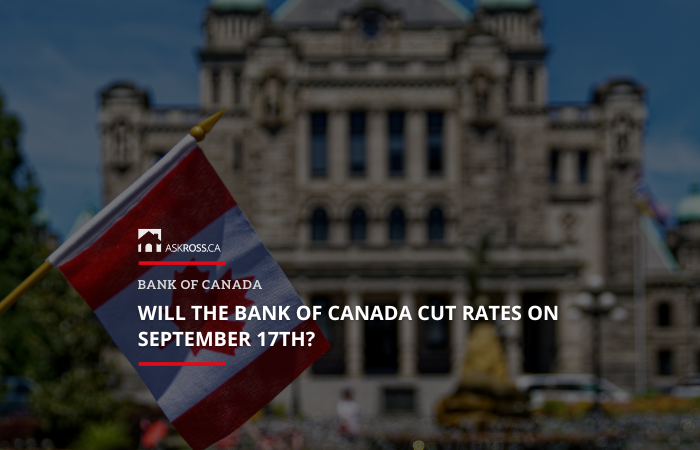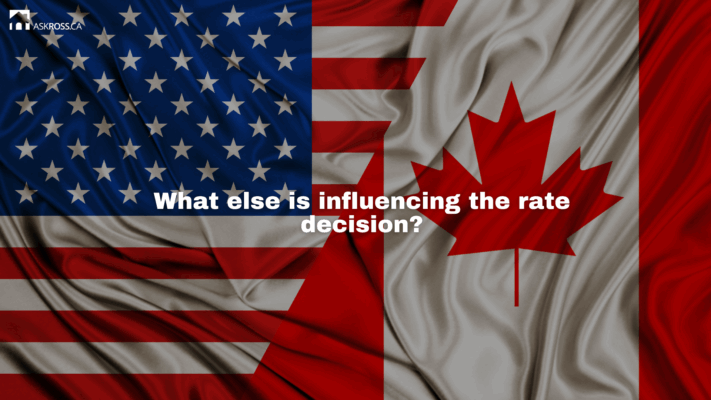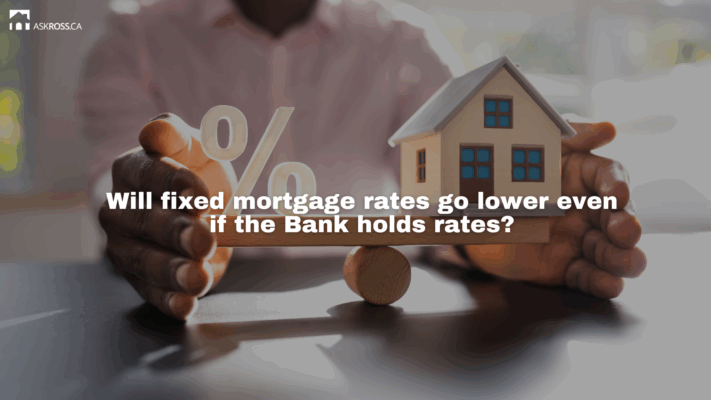
Published: September 15th, 2025 • Last Updated: December 6th, 2025
Author: Ross Taylor on AskRoss.ca
Update: The Bank of Canada Cuts the Policy Rate to 2.5% Here’s What You Need to Know
It’s official. On September 17th, the Bank of Canada cut the overnight rate by 25 basis points, bringing it down to 2.50%, marking the first rate cut since March 2025.
This move wasn’t exactly a shocker.
The writing was on the wall, especially after softer job numbers, declining GDP, and inflation momentum stalled in August.
Let’s break down what it means for your mortgage and your strategy heading into fall.
The economy pushed the Bank’s hand
In its statement, the Bank made it clear: the economy is slowing down faster than expected.
- Exports dropped 27% in Q2.
- Business investment is retreating.
- More than 100,000 jobs have been lost in the past two months, and
- Unemployment has climbed to 7.1%, with most of the pain hitting trade-sensitive industries like auto, steel, and manufacturing.
At the same time, inflation has cooled
The headline number came in at 1.9%, and even though core inflation is still sitting near 3%, its momentum has faded.
The federal government’s recent move to remove most retaliatory tariffs on U.S. goods is also easing price pressures on imported items.
All this added up to what Governor Tiff Macklem called a “clear consensus” at the Bank to cut rates now to better balance the risks going forward.
“We are focused on ensuring that Canadians continue to have confidence in price stability through this period of global upheaval. We will support economic growth while ensuring inflation remains well controlled.”
“We don’t want Canadians to have to worry about big increases in the cost of living,”
– Governor Tiff Macklem

The big question: will the Bank cut again in 2025?
Right now, the Bank is not making any bold forward-looking forecasts, a shift from their usual playbook.
Instead, they’re focused on how U.S. tariffs continue to evolve, how exports hold up through the fall, and whether job losses start to drag down household spending.
Still, economists are already predicting that further cuts are likely, potentially into early 2026.
If that happens, we could see prime rates head closer to 4.45%, which would be a major break for variable-rate borrowers.
What this means for mortgage holders
- If you’re in a variable-rate mortgage, your rate will likely drop in the next few days, assuming your lender passes along the full 0.25% cut.
- If you’re shopping for a new mortgage you’ll want to watch fixed rates. Bond yields dropped further on the news, which opens the door for additional fixed-rate reductions over the coming weeks.
- If you’re up for renewal, this could be your opportunity to secure a better deal and consider refinancing.
If you have any questions about how this rate cut affects your mortgage or buying plans, feel free to call us at 416-989-1000 or email [email protected] — we’re here to help.
Full breakdown below ↓↓
How a Rate Cut Could Change Your Mortgage and Buying Power
We’re approaching another pivotal moment in the Canadian economy, and once again, all eyes are on the Bank of Canada.
On September 17th, we’ll find out whether the Bank of Canada will cut the key overnight rate, and with the odds hovering around 68% for a 25-basis-point cut, you’re probably wondering: how will this affect my mortgage? Should I wait to buy? Should I refinance now?
Let’s break down what’s going on, what’s likely to happen, and most importantly, what it could mean for you, whether you’re a current homeowner or looking to get into the market.
Jump to a specific section in this article ↓↓
- Why are we expecting the Bank of Canada to cut interest rates this month?
- What would a rate cut mean for your mortgage?
- What economic factors are pushing the Bank of Canada toward a rate cut?
- What else is influencing the rate decision?
- Will fixed mortgage rates go lower even if the Bank holds rates?
- Is now a good time to buy or refinance?
- Key takeaway from Ross Taylor Mortgages
- All of the FAQs in this article: Will the Bank of Canada cut rates on September 17th?
- Additional FAQs for Canadians

Why are we expecting the Bank of Canada to cut interest rates this month?
After holding rates steady for much of 2025, the Bank of Canada may finally be ready to pull the trigger on a rate cut. And frankly, the signs are all pointing in that direction.
In August, Canada lost 66,000 jobs, pushing our national unemployment rate up to 7.1%. At the same time, GDP shrank for the third straight month.
That’s not just a slowdown, it’s a contraction. And that kind of economic weakness usually leads to monetary easing.
Inflation is still sticky at around 3%, but the Bank may decide that growth matters more right now.
Markets are currently pricing in a 68% chance of a 0.25% cut, with a full easing cycle potentially pushing the policy rate down to 2.0% by the end of 2026.
And remember, the Bank’s shift to “scenario planning” in recent statements shows they’re preparing for a variety of economic outcomes, not just a single forecast. That kind of flexibility is often a prelude to policy action.
↑↑ Back to the list at the top ↑↑

What would a rate cut mean for your mortgage?
If the Bank of Canada cuts the overnight rate from 2.75% to 2.50%, that would immediately lower the prime rate, which currently sits at 4.95%.
After the cut, prime would likely drop to 4.70%.
How will this affect variable-rate mortgage holders?
This is where the impact is felt the fastest.
- If you have a variable-rate mortgage, your rate is tied to prime, so you’ll see an immediate drop in your interest rate.
- If you’re on an adjustable payment schedule, your monthly payment could decrease.
- Depending on your loan amount, a 25-point drop could lower your monthly payment by roughly $15 to over $100.
- For a typical mortgage of $300,000 to $600,000, that usually works out to savings in the $20 to $60 range.
How will this affect fixed-rate borrowers?
If you’re in a fixed mortgage, nothing changes for you right away.
- However, the bond market is already anticipating lower rates. Government bond yields have dropped to around 2.7%, which has already started nudging fixed mortgage rates lower. Track current yield trends here.
Still, as I explained in our July 30th BoC update, even a dovish tone from the Bank doesn’t always prompt fixed rates to lower immediately.
The bond market often prices things in before the central bank acts.
↑↑ Back to the list at the top ↑↑

What economic factors are pushing the Bank of Canada toward a rate cut?
Let’s dig a bit deeper into the key trends shaping this decision. This isn’t just about inflation anymore; it’s about protecting a fragile economy.
Our labour market is weakening
Unemployment climbing to 7.1% with 66,000 jobs lost is a red flag. And these aren’t just seasonal blips; we’re seeing consistent softening
- Sectors like manufacturing and exports are being hit hardest.
- Youth unemployment has now risen above 13%, showing how difficult it’s becoming for younger Canadians to enter the workforce.
That kind of weakness puts serious pressure on the Bank to act, even if inflation is still above target.
Canada’s economy is shrinking
Real GDP fell by 1.6% in Q2, matching the Bank’s internal projections. As we discussed in July, the Bank is especially concerned about declining exports, slower business investment, and softening consumer spending.
When those indicators flash red, cuts become more likely.
Inflation is still a concern, but…
Core inflation remains around 3%, which is above the 2% target.
But with employment weakening and growth falling off, the Bank is now willing to tolerate above-target inflation for a while longer.
Especially if its underlying data and some economists suggest “true” inflation is closer to 2.5%.
↑↑ Back to the list at the top ↑↑

What else is influencing the rate decision?
The US Federal Reserve is cutting too
The U.S. Fed is widely expected to cut rates this month, the first time since 2023.
When major central banks move in sync, it gives others cover to follow suit without destabilizing currency markets or triggering capital flight. Cross-border coordination is an underrated but important factor in Canada’s decisions.
Trade tariffs are driving scenario planning
The real wildcard? Trade. U.S. tariff policy toward Canadian goods is in flux. In fact, the Bank has abandoned traditional forecasting altogether in favour of scenario planning, and those scenarios paint three very different outcomes depending on how trade tensions play out.
↑↑ Back to the list at the top ↑↑

Will fixed mortgage rates go lower even if the Bank holds rates?
Yes, and that’s something most borrowers overlook.
Fixed rates are more sensitive to bond yields than the BoC’s overnight rate. And right now, yields are falling in anticipation of lower policy rates in the months ahead. Even if the Bank holds on September 17th, fixed rates could still drift lower.
But don’t expect fireworks. As I explained in our July 30th article, fixed rates move gradually, and the market has already priced in a good chunk of the expected easing cycle.
↑↑ Back to the list at the top ↑↑

Is now a good time to buy or refinance?
This is where strategy becomes more important than timing.
Are you looking to buy?
Affordability is starting to improve thanks to softer rates, but don’t expect a dramatic shift overnight.
- The real opportunity comes if you can find a motivated seller before the market reacts to the next rate cut.
Are you considering a refinance?
Now is a great time to get quotes. You don’t need to wait for the actual cut; bond markets have already built in expectations.
- If you’re carrying unsecured debt, even a 0.25% drop in your mortgage rate could make a real difference in your cash flow.
If you’re in a fixed-rate mortgage
Fixed rates follow bond yields more closely than the Bank of Canada’s policy rate.
- Yields have already fallen toward 2.7% in anticipation of cuts.
- That means fixed rates could continue drifting lower, even if the Bank holds steady on September 17th.
- However, lenders don’t always pass on lower costs immediately. Often, they wait for a formal Bank of Canada move to avoid repricing mortgages twice.
Are you thinking about switching from a fixed to a variable?
If you’re considering switching to a variable rate, your decision should be based on more than just rate speculation.
- As I outlined in this recent deep dive, variable rates may outperform over the next 12 to 24 months, but only if inflation continues cooling and trade tensions don’t explode.
↑↑ Back to the list at the top ↑↑

Key takeaway from Ross Taylor Mortgages
This isn’t just another rate announcement; it’s potentially the start of a long-anticipated pivot.
The Bank of Canada is clearly responding to weak data, soft inflation momentum, and an increasingly uncertain global backdrop.
Whether the cut comes this month or next, we are entering a new rate environment.
If you’ve been sitting on the fence, now’s the time to reevaluate. Rates are shifting, affordability is improving, and lenders are starting to get competitive again.
Let’s talk about how to take advantage of this.
Whether you’re buying, renewing, or refinancing, don’t wait for headlines to dictate your mortgage strategy. Because when the Bank finally moves, you’ll want to already be one step ahead.
↑↑ Back to the list at the top ↑↑

All of the FAQs in this article: Will the Bank of Canada Cut Rates on September 17th
Will the Bank of Canada cut rates on September 17th?
- Markets currently see about a 68% chance of a 0.25% cut, but the final decision will depend on incoming economic data and global conditions.
Why are people expecting the Bank of Canada to cut interest rates this month?
- Canada’s economy is weakening with rising unemployment, shrinking GDP, and sticky inflation, which increases the likelihood of a rate cut to stimulate growth.
What would a rate cut mean for your mortgage?
- A rate cut would lower the prime rate, immediately reducing costs for variable-rate mortgage holders while nudging fixed rates lower through bond market activity.
How will this affect variable-rate mortgage holders?
- Variable-rate borrowers would see their interest rates and potentially monthly payments decrease, saving about $20 to $60 per month, depending on loan size.
How will this affect fixed-rate borrowers?
- Fixed-rate borrowers will not see immediate changes, but lower bond yields are already gradually pushing fixed rates down.
What economic factors are pushing the Bank of Canada toward a rate cut?
- High unemployment, GDP contraction, and softening consumer demand are pressuring the Bank to cut rates, despite inflation being slightly above target.
What else is influencing the rate decision?
- U.S. Federal Reserve cuts and uncertainty around trade tariffs are influencing the Bank of Canada’s move, with scenario planning guiding policy.
Will fixed mortgage rates go lower even if the Bank holds rates?
- Yes, fixed rates could still decline as they are more tied to falling bond yields than the Bank of Canada’s policy rate.
Is now a good time to buy or refinance?
- Affordability is improving, and bond markets have already priced in cuts, making it a good time to shop for refinancing or take advantage of motivated sellers.
Are you thinking about switching from a fixed to a variable?
- Switching depends on risk tolerance, as variables may outperform if inflation continues to ease and trade tensions remain manageable.
↑↑ Back to the list at the top ↑↑
Additional FAQs for Canadians
How does a Bank of Canada rate cut affect home affordability?
- Lower rates reduce borrowing costs, which can improve affordability, though housing prices may adjust if demand rises.
What happens to the Canadian dollar if the Bank of Canada cuts rates?
- A rate cut typically weakens the Canadian dollar, especially if the U.S. Federal Reserve holds steady or cuts less aggressively.
How often does the Bank of Canada meet to set interest rates?
- The Bank of Canada holds eight scheduled interest rate announcements each year, roughly every six weeks.
Should I lock in my mortgage rate before the Bank of Canada’s decision?
- If you are risk-averse, locking in secures current rates, but if you expect cuts, waiting may give you access to lower rates.
How do Bank of Canada decisions impact credit cards and lines of credit?
- Since they are tied to prime, a cut would reduce interest costs on variable-rate credit products like lines of credit and some credit cards.

Ross Taylor Mortgages
If you want great service from someone you can trust – reach out to us today.
Get quick answers to your questions, no matter how difficult – 7 days a week.

 Apply For a Mortgage
Apply For a Mortgage